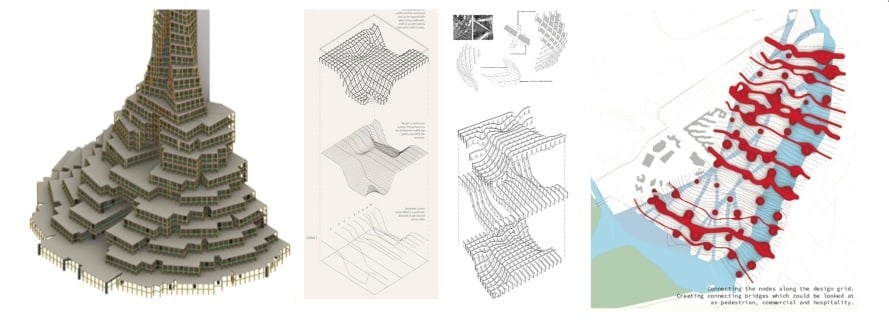
In today’s fast-moving AEC industry, pursuing a Master’s degree is no longer the only path to success. Many ambitious architects are skipping the two-year academic route altogether and still building thriving careers.
The key? Learning smarter, not longer.
Here’s the truth: the architectural landscape is evolving rapidly. Design technology, BIM workflows, sustainable innovation, and collaborative tools are transforming the way firms operate. While a Master’s degree still has value in research or academia, it's no longer a requirement to land great roles or make an impact.
This blog walks you through a smarter alternative, one that focuses on real-world experience, skill-building, and industry readiness. If you’re ready to level up your career without spending years and lakhs on postgraduate education, here’s your game plan.
Let’s break the myth that a Master’s is the only map to success. It’s time to design your route that is faster, smarter, and just as rewarding.
Why a Master’s Degree Isn’t the Only Route
Think outside the (studio) box.
For decades, a Master’s degree was considered the logical next step after a B.Arch (Bachelor of Architecture). But times have changed, and so have the rules of the game.
Here’s why an M.Arch (Master of Architecture) isn’t always necessary:
- Not Required for Most Firms
Unless you're aiming for academia or certain government roles, most architecture firms don’t demand a Master’s. They care more about what you can do than what degree you have. - The cost-to-return ratio doesn’t always add up
With tuition, living expenses, and opportunity costs, an M.Arch in India can set you back ₹3–6 lakhs (source). Many architects don’t see a proportional salary hike after graduation.
- Tech Skills > Theory
The industry values practical knowledge. Employers prioritise candidates skilled in BIM, Revit, Rhino, and parametric tools over those with purely academic credentials. - Faster, Targeted Alternative Exists
Short-term certifications and hands-on training offer more focused, industry-aligned learning often in less time and for a fraction of the cost.
Success today depends less on formal degrees and more on agility, initiative, and up-to-date skills. If you’re strategic, you can bypass the Master's and still stand shoulder-to-shoulder with the best in the field.
Gaining Practical Experience
What you build matters more than what you studied.
In architecture, hands-on experience isn’t just valuable; it’s essential. The ability to take a design from idea to execution can’t be fully taught in a classroom. That’s why gaining practical exposure early can give you a major edge over M.Arch grads who are still in theory mode.
Here’s how to start building experience smartly:
- Intern at Small to Mid-Sized Firms
These firms often let you take on more responsibility than big-name studios. You’ll learn client communication, site visits, project coordination, and maybe even get to lead design work. - Work on Freelance or Personal Projects
Help a friend redesign a café. Participate in design competitions. Volunteer on local community projects. Every sketch and site plan counts towards building your expertise. - Document Everything
Keep a record of your contributions, like site photos, concept sketches, and final drawings. These become assets for your portfolio and interviews. - Collaborate with Civil Engineers and Contractors
Understanding how your designs are built on-site gives you invaluable insight into real-world challenges. - Work with Industry Professionals
If you can, tag along with senior architects or site managers to absorb the bits of the business side of architecture.
Practical experience not only sharpens your skills but also shows employers that you're already thinking like a professional degree or not.
Leveraging Online Courses and Certifications
Why wait two years when you can learn it in seven months?
In an industry where new tools and workflows emerge every year, staying relevant means staying updated. Online courses and certifications, like those of Novatr, offer a flexible, fast, and focused way to upgrade your skills without the commitment or cost of a Master’s.
Here’s how to make the most of them:
- Pick Future-Ready Topics
Focus on what’s in demand: Building Information Modelling (BIM), parametric design, sustainable architecture, Revit, Rhino, Grasshopper, and project management. - Choose Industry-Led Platforms
Platforms like Novatr offer programs designed by professionals, so what you learn is aligned with real-world expectations. - Learn at Your Pace
Many of these programs are self-paced or part-time, making them ideal for working professionals or fresh graduates balancing internships. - Build Alongside Learning
Good certification programs are project-based. You don’t just learn software; rather, you apply it to actual architectural problems, strengthening both your skills and your portfolio. - Earn Credibility
A well-recognised certificate from an industry-backed platform tells recruiters you're proactive, skilled, and ready to contribute from day one.
When chosen strategically, online certifications like Novatr’s BIM Professional Course for Architects can do what a Master’s often can’t, i.e., making you job-ready in a matter of months.
Building a Compelling Portfolio
Your portfolio is your passport. Make it unforgettable.
In architecture, your portfolio often speaks louder than your resume or your degree. It’s the most powerful tool you can wield to land jobs, freelance gigs, or even collaborations. And the best part? You don’t need a Master’s to build a great one.
Here’s how to craft a portfolio that gets noticed:
- Include Real-World Projects
Whether it’s freelance work, internships, or personal projects, anything built or in progress shows your ability to execute. - Tell the Story Behind the Design
Use captions to explain your thinking, problem-solving, and approach. Design without context is just decoration. - Quality > Quantity
A curated selection of 6–8 strong projects is better than 20 average ones. Make every page count. - Go Digital
Maintain both a PDF and an online portfolio (through Behance or your site). Make it easy to share and view on any device.
A Master’s degree might get your foot in the door, but a well-crafted portfolio can open the door.
Strategic Networking
It’s not just what you know; it’s who knows you.
In architecture, opportunities often come through conversations, not job boards. Strategic networking helps you stay visible, relevant, and connected to the pulse of the industry, even without a Master’s degree.
Here’s how to build meaningful professional connections:
- Attend Industry Events
Design exhibitions, architecture festivals, conferences, and workshops are goldmines for meeting like-minded professionals and potential mentors. - Join Online Communities
Platforms like LinkedIn, Instagram (yes, even Instagram!), and Discord host vibrant architecture communities where people share work, opportunities, and resources. - Reach Out to Alumni and Mentors
Don’t hesitate to message architects whom you admire or alumni from your college. A thoughtful question or comment can spark long-term mentorship.
Networking isn’t about collecting contacts; it’s about building trust. And when you do, opportunities often find you, not the other way around.
Staying Updated with Industry Trends
In architecture, being relevant is more powerful than being traditional.
With design technologies, sustainability practices, and client expectations evolving every few months, staying current is non-negotiable, especially if you’re carving a career without the conventional M.Arch route.
Here’s how to stay ahead of the curve:
- Follow Design and Architecture Platforms
Keep tabs on global platforms like ArchDaily, Dezeen, and DesignBoom. They’re hubs for trends, case studies, and emerging technologies. - Subscribe to Newsletters
Joining Novatr’s email newsletters can help you stay up-to-date. - Take Micro-Courses Regularly
Instead of waiting for major upskilling moments, treat your learning like a gym routine, being consistent and modular. - Study Trending Project Types
From passive housing to modular buildings, understanding what clients are asking for today helps you position yourself as the architect of tomorrow.
In an industry where trends can shape careers, those who stay informed, not just educated and end up leading the way.
Conclusion
Who said a degree defines your destiny?
Building a successful architecture career without a Master’s is not only possible, it’s becoming increasingly normal. The industry no longer runs on rigid rules. It rewards those who are curious, adaptable, and committed to continuous learning.
Remember that clients don’t ask for your degree; they ask what you can build. In a world where architecture is evolving faster than ever, your career path doesn’t have to be conventional. It has to be intentional.
So, forget the blueprint someone else drew for you. Create your own. One bold decision, one smart skill, one opportunity at a time.
- Visit the Novatr Homepage to understand our mission in transforming AEC education.
- Browse through our Courses Page to find specialised programs tailored for architects and designers.
Dive into the Learning Hub for in-depth insights, industry trends, and expert resources to stay ahead in the field.
FAQs
1. What is the average cost of pursuing an M.Arch in India?
The average cost of an M.Arch in India ranges from ₹6 to ₹10 lakhs, including tuition, materials, and living expenses, making it a significant financial investment.
2. What is the average starting salary for M.Arch graduates in India?
M.Arch graduates typically start with salaries between ₹3.5–₹6 LPA, depending on location, specialisation, and firm, often not significantly higher than B.Arch graduates.
3. How long does it typically take to recoup the investment made in an M.Arch degree?
It typically takes 4–6 years to break even on an M.Arch investment, considering salary growth and career progression in most Indian firms..
4. Are there specialisations within M.Arch that offer better ROI?
Yes, specialisations like Sustainable Architecture, Urban Planning, or Digital Architecture offer better ROI, especially when paired with relevant skills like BIM or parametric design.
5. How does the ROI of an M.Arch compare to alternative educational paths like certification programs?
Certification programs are shorter, more affordable, and job-focused, delivering faster ROI and direct alignment with industry demands, especially when combined with in-demand skills like BIM or parametric design.
Was this content helpful to you












-1.png)
.png)